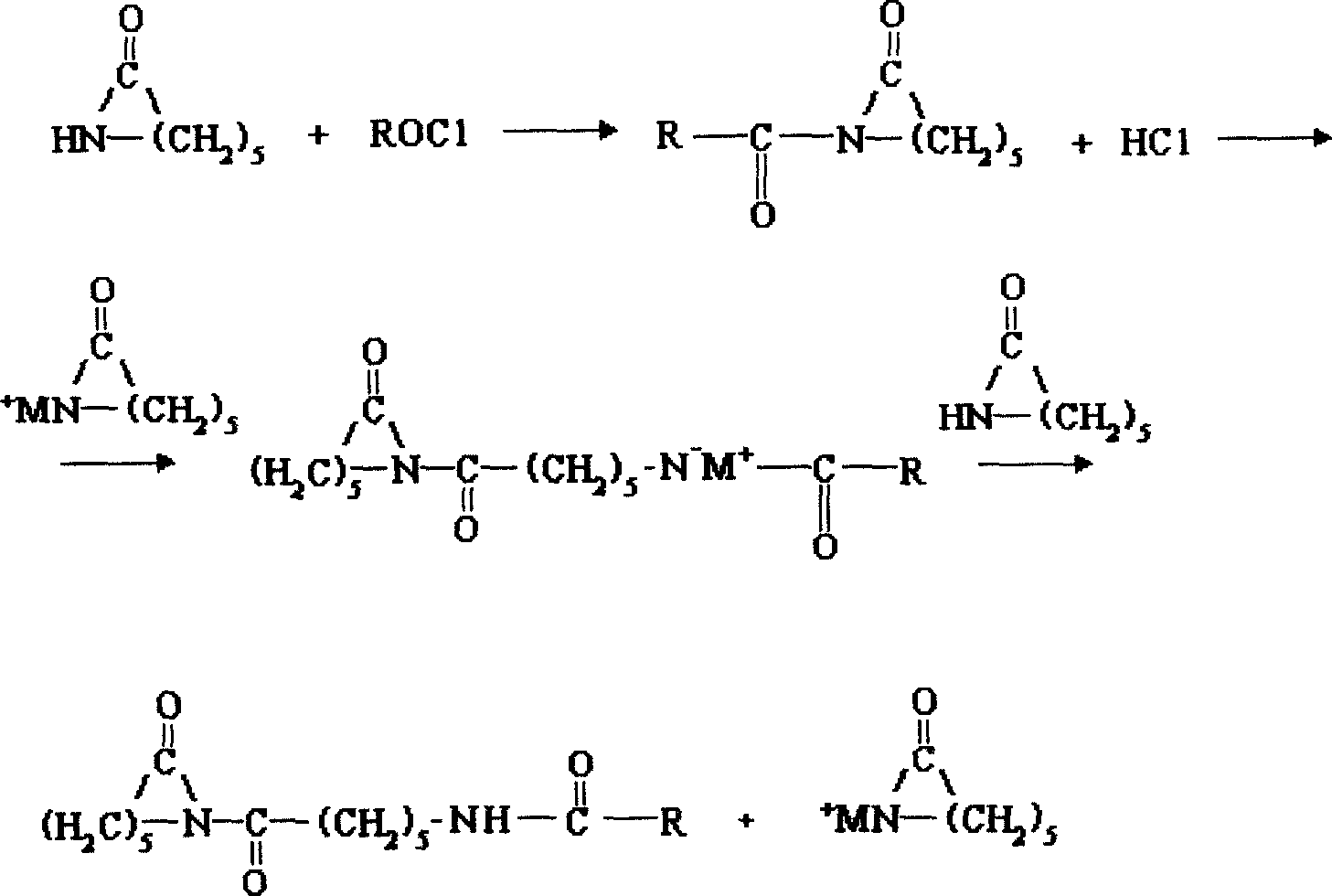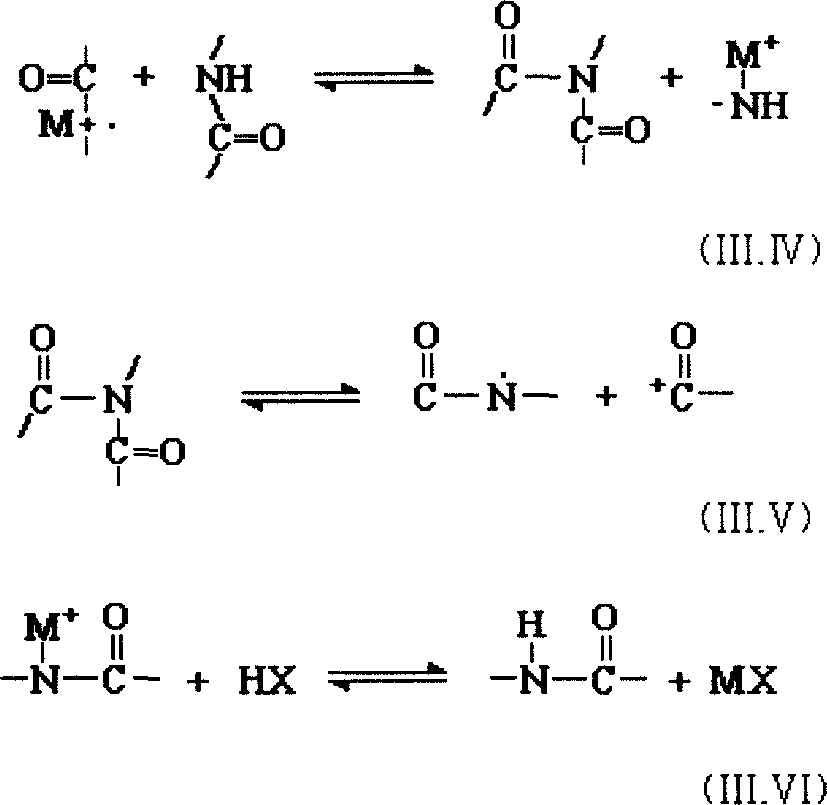Anion slurry polymerization method for preparing caprolactam homopolymer and copolymer
A technology of caprolactam and acid chloride, which is applied in the field of anionic slurry polymerization for the preparation of caprolactam homopolymers and copolymers, and can solve the problems of difficulty in stable control of the molecular weight of reaction products, residues, and limited secondary forming and processing of slices.
- Summary
- Abstract
- Description
- Claims
- Application Information
AI Technical Summary
Problems solved by technology
Method used
Image
Examples
preparation example Construction
[0010] The preparation method of the present invention is specifically described below.
[0011] Homopolymerization of caprolactam
[0012] Put the caprolactam monomer into the reactor and heat it to a temperature of 70-120°C, vacuumize to remove the trace moisture absorbed by the monomer until the moisture content is lower than 0.02wt%, and then add 1.0×10 based on the weight of the monomer -3 -8.0×10 -3 % of alkali or alkali metal catalyst, continue vacuuming at 90-120°C, remove the water generated by the reaction until the moisture content is lower than 0.015wt%, and add 1.2-4.8mol% acid chloride, lattice co-catalysts such as Nicholas' reagent or isocyanate, and at the same time add an inert aliphatic hydrocarbon dispersant in an amount of 4-30 wt% of the monomer weight. Heating under stirring until the temperature reaches 140-160°C, the reaction system changes from clear and transparent to turbid, and a large amount of granular polymers are produced within 10-20 minutes....
Embodiment 1
[0033] Embodiment 1: the synthesis of nylon 6 homopolymer
[0034] Add 10kg of caprolactam monomer to a 50-liter reactor, heat to a temperature of 70-120°C, vacuumize to remove the trace moisture absorbed by the monomer until the moisture content is lower than 0.02wt%, and add 0.2×10 -2 The sodium hydroxide catalyst of wt%, continues to vacuumize at 90-120 ℃, gets rid of the water that reaction generates to moisture content and is lower than 0.015wt%, adds the cocatalyst toluene diisocyanate of 1.63mol% and 2.5 liters of dispersant kerosene ( Industrial pure, boiling point range 160-220°C). After reacting at 155°C for 30 minutes, nylon 6 slurry with a monomer conversion rate of 45% was obtained. At this reaction temperature, acetic acid (1.0 wt% based on the amount of caprolactam) with pKa=4.74 was added, and stirred for 20 minutes to remove residual catalyst and residual The active center is passivated, then discharged, filtered, washed, and dried to obtain dry powder PA6. A...
Embodiment 2
[0035] Embodiment 2: Preparation of low melting point hot melt adhesive
[0036] Add 10kg of caprolactam monomer into a 50-liter reactor, heat to a temperature of 70-120°C, vacuumize to remove the trace moisture absorbed by the monomer until the moisture content is lower than 0.02wt%, and add 0.2×10 -2 Wt% sodium hydroxide catalyst, continue vacuuming at 90-120°C for 30 minutes, remove the water generated by the reaction until the moisture content is lower than 0.015wt%, add 2.0mol% co-catalyst toluene diisocyanate, and add a molecular weight of 1000 PEG (6% of the weight of caprolactam), add 2.5 liters of dispersant kerosene (industrial pure, boiling point range 180-220°C) under stirring, heat up to 115-170°C and stir for 20-30 minutes to obtain a single PA6 / PEG copolymer slurry with a volume conversion rate of 40-45%. After discharge, it is filtered, washed, and dried to obtain a powdery PA6 / PEG copolymer. After testing, its melting point is 120°C and its molecular weight is...
PUM
| Property | Measurement | Unit |
|---|---|---|
| Linear density | aaaaa | aaaaa |
| Breaking strength | aaaaa | aaaaa |
| Molecular weight | aaaaa | aaaaa |
Abstract
Description
Claims
Application Information
 Login to View More
Login to View More - R&D
- Intellectual Property
- Life Sciences
- Materials
- Tech Scout
- Unparalleled Data Quality
- Higher Quality Content
- 60% Fewer Hallucinations
Browse by: Latest US Patents, China's latest patents, Technical Efficacy Thesaurus, Application Domain, Technology Topic, Popular Technical Reports.
© 2025 PatSnap. All rights reserved.Legal|Privacy policy|Modern Slavery Act Transparency Statement|Sitemap|About US| Contact US: help@patsnap.com



